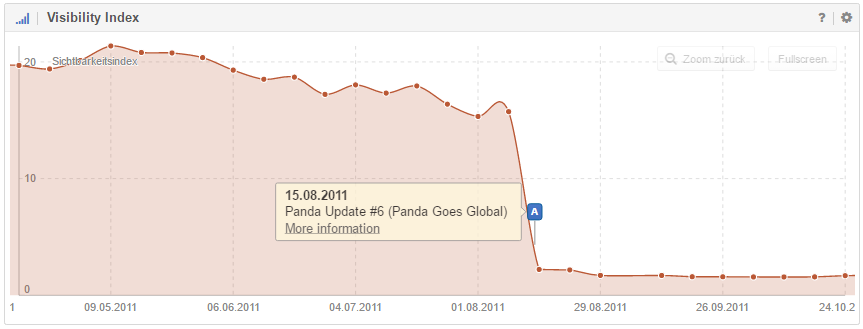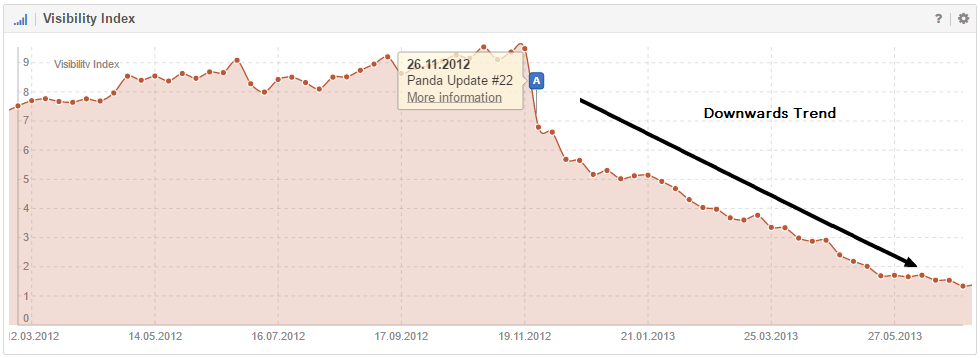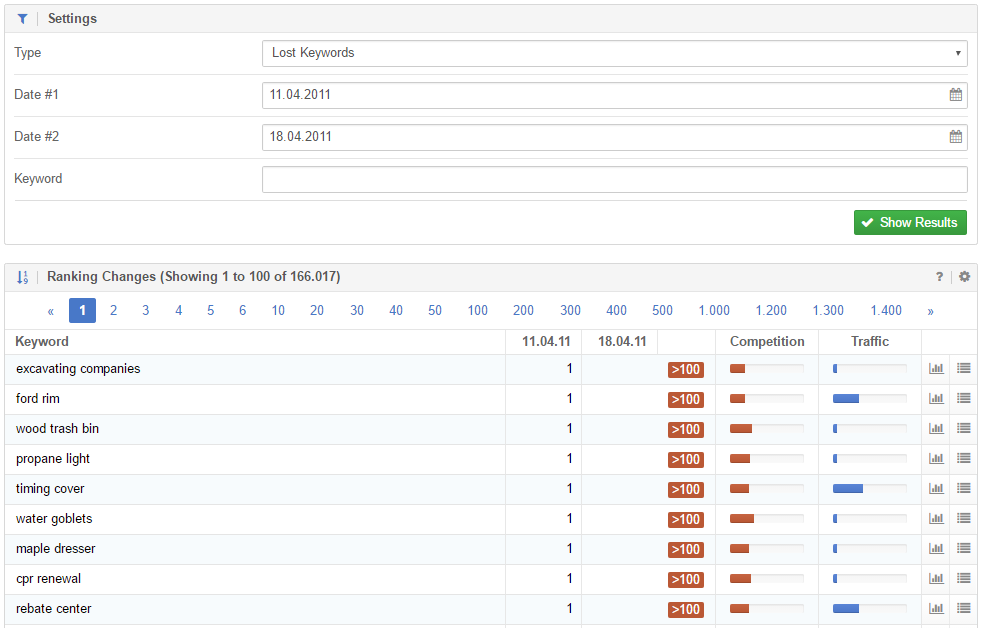The codename “Panda” refers to a large and permanent change to Google’s ranking algorithm and was deployed in Feb 2011.
- What is the Google Panda Update?
- What makes this algorithm change so special?
- What is the goal of the Panda Update?
- How is the quality of a website determined?
- How can you find out if a website is affected by the Panda Update?
- What to do if you are affected by a Google penalty
- Video explanation by Matt Cutts / Google on this topic
- What should a site owner do if they think they might be affected by Panda?
- Additional information on this topic:
What is the Google Panda Update?
To be more specific – the Panda Update is a filter that is regularly applied to the entire Google index, in order to lower the visibility of low quality websites (or rather noticeable worsen their ranking positions).
The algorithm change was initially deployed to the US-American search market on February 23rd, 2011. It was then rolled-out for all English language search requests worldwide on April 11th, 2011.
On August 12th, 2011, the ranking algorithm change was deployed to all other available search markets worldwide, except for the languages Chinese, Japanese and Korean. This date is generally talked about as the worldwide release of the Google Panda Update.
The namesake for this algorithm change is the Google engineer Navneet Panda.
What makes this algorithm change so special?
Compared to earlier algorithm changes, it is noticeable that the Panda Update is more likely to affect the rankings of an entire website or parts thereof, instead of just going after individual (sub-)pages.
According to Google, the algorithm change impacted about 12% of all English language search requests, as well as about 6-9% for all other available languages. This led to a very noticeable effect in the search results.
What is the goal of the Panda Update?
The goal of this algorithm change is to further increase the quality of the search results.
Both in theory and actuality, the searcher (User) will see more high quality websites in the search results, as low quality websites are pushed to the back of the search engine result pages (SERPs).
This means that the Google Panda Update makes up the basis of calculation (Filter) for whether a website (and its content) is of high or low quality.
How is the quality of a website determined?
After the introduction of this algorithm change, it became apparent for website administrators that the following website factors have a negative impact on their visibility in the search results:
- not a lot of unique content
- few or no high quality backlinks
- short visitor retention times (time on page & time on site)
- a large percentage of duplicate content
- a high bounce rate
- a high percentage of pages with nearly no unique/original content
- a high percentage of so called boilerplate content (e.g., the same texts or links on every page)
- a high number of irrelevant advertisements (or generally too many ads)
- page content and page title do not match the search request
- unnaturally high repetition of the same word on a page
This means: If Google, or rather the “Panda” filter, identifies these factors on a website, then this might lead ot a loss of visibility in the search results. The website is then affected by the Panda Update.
How can you find out if a website is affected by the Panda Update?
If a website has lost a lot of visibility by being pushed to the back of the SERPs, shortly after the algorithm change was applied, then the likelihood of the page being affected by the Panda Update is rather high.
Example:
You can determine the Visibility of a domain in the search results with the SISTRIX Toolbox.

A strong downward trend in the Visibility Index of a domain that has been affected by the Panda Update is also a common sight. Getting back on track often means a significant amount of work has to be done.

If you notice a fall of important keywords with previously good rankings over the same timespan, you have another telltale sign that the website has been affected by the “Panda” algorithm change.

You can identify significant ranking changes for a domain with the SISTRIX Toolbox:

What to do if you are affected by a Google penalty
- Work on getting an overview of the situation
- is the entire website affected, or just parts of it?
- what are the differences between the websites that are affected and those that are not?
- is there a difference in the quality of content, when compared to competitors who have not been affected?
- Analyse the website
- do the above quality factors apply to the entire website or just parts of it?
- are there pages with positive signals (where the above factors do not apply)?
- Improve the website
- Create content in compliance with the Google Quality Guidelines
- Improve the usability and accessibility of your website
- https://webmasters.googleblog.com/2011/05/more-guidance-on-building-high-quality.html
Video explanation by Matt Cutts / Google on this topic
What should a site owner do if they think they might be affected by Panda?
Recently Google has integrated the Panda update in to its normal indexing process. Now, how will webmaster come to know whether her site is hit by Panda? And, if her site is already hit, how she will recover?